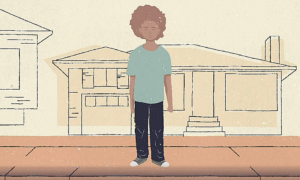 For a mother of two daughters in Will County, Illinois, known in legal papers as Kelly, the morning of May 1 began with her being thrown against a wall so hard she saw stars. When she looked up, she saw the man who did that to her — the father of her children — holding a gun and threatening to use it. Then the father took one of the children and fled. Kelly was terrified the father would hurt her child.
For a mother of two daughters in Will County, Illinois, known in legal papers as Kelly, the morning of May 1 began with her being thrown against a wall so hard she saw stars. When she looked up, she saw the man who did that to her — the father of her children — holding a gun and threatening to use it. Then the father took one of the children and fled. Kelly was terrified the father would hurt her child.
But, as is documented in a civil rights lawsuit filed by the Family Defense Center in Chicago, that was just the start of a nightmare that has not ended — thanks to the Illinois child welfare system.
Someone — Kelly doesn’t know who and probably never will — called the Illinois child abuse hotline. Even though the father is facing criminal charges and even though Kelly has primary legal custody of the children, caseworkers for the Illinois Department of Children and Family Services apparently leaped to the conclusion that, somehow, all this was Kelly’s fault. They coerced her into letting them put both children with the alleged abuser’s parents. A private agency now oversees the case. The alleged abuser has liberal contact with his children while Kelly hasn’t had a visit with them for a month.
Meanwhile, caseworkers are forcing Kelly to jump through all the usual hoops, including a “mental health assessment” and “anger management.” (Remember, she’s not the one who threw someone against a wall, she’s not the one who pulled out a gun, and she’s not the one facing criminal charges.)
Then, according to the complaint, in what may be the single most candid statement ever uttered by a child welfare worker, a caseworker for the private agency explained how the system really works: The case, she explained, is a “maze.” Like mice in a cruel lab experiment, both parents are at the “beginning of the maze.” The children are at “the end of the maze.” She then said that “whichever parent finished his or her services first” wins — that is, he or she would get the children.
By now some may be wondering “where are the courts — aren’t they supposed to approve all this?” But child welfare agencies have ways around pesky nuisances like due process of law. In this case, they effectively blackmailed Kelly into giving up what few rights she had. They told her that unless she agreed to a so-called “safety plan” in which the children were placed “voluntarily” with the abuser’s parents, she’d have no contact of any kind with her children.
There is nothing to suggest this case is unusual. In an almost identical case last year, Illinois reached a settlement agreement to curb the abuse of “safety plans.” They violated the agreement and have yet to adopt the policies they promised to follow.
And Illinois is not alone in blaming mothers for being beaten.
In Utah, a legislative audit report found that children “witnessing domestic violence” is the single largest category for so-called “substantiated” maltreatment.
In New York City the practice of tearing children from their mothers just because the mothers had been beaten was largely ended only after a settlement that followed a federal judge’s scathing 183-page decision in a class-action lawsuit. (My organization’s vice president was co-counsel for the plaintiffs.)
As the decision explains, the lead plaintiff in that case, Sharwline Nicholson was beaten mercilessly by a boyfriend when she decided to break off the relationship.
But even as she was bleeding profusely, suffering from a broken arm, broken ribs and gashes to her head, as she called 911 and waited for an ambulance to take her to a hospital, she arranged for a neighbor to care for her children.
But that wasn’t enough for the city’s child protective services agency. As Nicholson lay in her hospital bed, CPS took the children from the babysitter and threw them into foster care with strangers — where one of the children was abused. Nicholson was charged with “engaging in domestic violence” — presumably by throwing her body into her abuser’s fists.
“It reached the point where I said ‘Oh, why did I call 911,’” Nicholson said.
Cases like this keep happening because of the child welfare system’s penchant for embracing fads — and for always blaming parents, especially mothers, for anything that happens to children.
So a study reports the obvious: Witnessing domestic violence can be emotionally harmful to children. Instead of embracing the obvious solution — arrest the batterer and put him in jail — child protective services rushes to blame the victim — and tear apart the family.
As usually happens when child protective services takes a swing at “bad mothers,” the blow lands on the children. As a succession of experts testified in the Nicholson case, while witnessing domestic violence may indeed be harmful to children, tearing those children from the victim of that violence is far, far worse. One expert called it “tantamount to pouring salt into an open wound.”
Fortunately, the New York City child welfare agency has largely abided by the settlement. And the New York State Court of Appeals effectively extended it statewide.
But that leaves 49 states where battered mothers have to think twice about seeking help — because of what the “helpers” might do to their children. That’s 49 states, where practice in these kinds of cases can boil down to “please pass the salt.”
Richard Wexler is executive director of the National Coalition for Child Protection Reform.





























